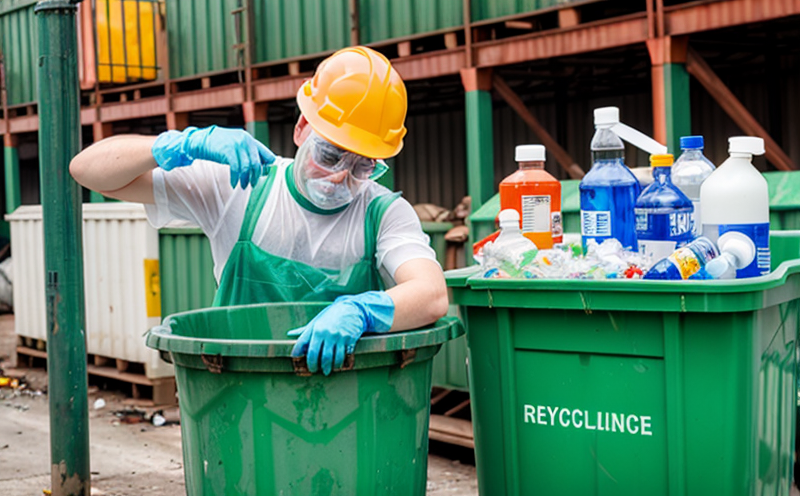ASTM E1908 Waste Contaminant Testing by XRF
The ASTM E1908 standard provides a robust framework for the determination of contaminant elements in waste materials using X-ray fluorescence (XRF) spectroscopy. This service is particularly crucial for quality managers, compliance officers, R&D engineers, and procurement teams involved in the waste management and recycling sectors. The ASTM E1908 method ensures accurate quantification of key contaminants such as lead, cadmium, mercury, and other hazardous substances that can impact environmental safety.
The XRF technique is well-suited for its non-destructive nature and rapid analysis capabilities. This makes it an invaluable tool in the waste sector where time and precision are critical. The ASTM E1908 method allows for efficient characterization of waste streams, helping to ensure compliance with local, national, and international regulations such as EU Directive 2008/98/EC on Waste Framework.
The ASTM E1908 standard specifies the use of specific XRF equipment parameters. These include the choice of excitation source (usually a high-purity xenon lamp or a radioactive source), detector type, and calibration standards. The method also details the specimen preparation steps necessary to achieve accurate results. Typically, this involves crushing and sieving waste samples into a fine powder for optimal analysis.
The ASTM E1908 methodology requires careful attention to detail in sample handling and analysis settings to ensure accurate contaminant identification and quantification. This includes setting the excitation voltage and current appropriately based on the elements being analyzed, optimizing the measurement time, and using the correct calibration standards. The standard also provides guidance on how to handle matrix effects that can influence the accuracy of XRF measurements.
The ASTM E1908 method is designed to provide precise results even in complex waste matrices. By adhering strictly to the outlined procedures, laboratories can ensure reliable contaminant detection and quantification, which is essential for compliance with regulatory requirements such as EU Directive 2008/98/EC.
The ASTM E1908 method is widely used in various sectors including electronics manufacturing, automotive recycling, and municipal solid waste management. By ensuring that waste materials meet strict contaminant thresholds, this service helps protect the environment and human health while also supporting sustainable resource recovery practices.
Why It Matters
The importance of ASTM E1908 cannot be overstated, particularly for industries dealing with waste materials. The service ensures that waste streams are free from hazardous contaminants that could pose risks to both human health and the environment. By adhering to this standard, businesses can ensure compliance with regulatory requirements, avoid costly fines, and maintain a positive reputation as sustainable operators.
The ASTM E1908 method is particularly critical for industries like electronics manufacturing, automotive recycling, and municipal solid waste management. In these sectors, waste materials often contain valuable resources that can be recovered if processed correctly. By ensuring that these materials meet strict contaminant thresholds, the service supports sustainable resource recovery practices.
In addition to environmental benefits, compliance with ASTM E1908 can also have significant economic advantages for businesses. By avoiding non-compliance penalties and demonstrating a commitment to sustainability, companies can enhance their competitive edge in the marketplace. This is especially true in regions where stringent waste management regulations are in place, such as the European Union.
The service also plays a crucial role in reducing the environmental footprint of industries by ensuring that waste materials are processed safely and efficiently. By identifying and removing hazardous contaminants before disposal or recycling, businesses can help protect ecosystems and reduce pollution levels.
Scope and Methodology
| Parameter | Description |
|---|---|
| Excitation Source | High-purity xenon lamp or radioactive source |
| Detection Limits | Elemental concentrations down to ppm levels |
| Sample Preparation | Crushing and sieving waste samples into a fine powder |
| Calibration Standards | Specifically formulated for the ASTM E1908 method |
The ASTM E1908 method is designed to provide precise results even in complex waste matrices. By adhering strictly to the outlined procedures, laboratories can ensure reliable contaminant detection and quantification.
Use Cases and Application Examples
- Electronics manufacturing: Ensuring that electronic waste does not contain harmful levels of lead or cadmium.
- Automotive recycling: Verifying the safety of recycled materials used in new vehicle production.
- Municipal solid waste management: Identifying hazardous contaminants in mixed waste streams for proper disposal.
| Use Case | Description |
|---|---|
| Electronics Manufacturing | The ASTM E1908 method ensures that electronic waste does not contain harmful levels of lead or cadmium. |
| Automotive Recycling | Verifying the safety of recycled materials used in new vehicle production. |
| Municipal Solid Waste Management | Identifying hazardous contaminants in mixed waste streams for proper disposal. |





